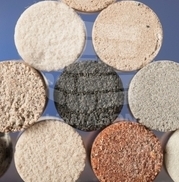
40% of global carbon dioxide emissions are linked to the construction industry, primarily from exhaustive material production and disposal processes. At bioMASON, they grow their materials by employing microorganisms to grow cement.The inspiration for these bricks came from Gingers study of coral reefs and the process of calcification that leads to their build up. BioMason’s eco-friendly bricks also use the natural process of calcification to gain their structure and strength. To create the bricks, sand is put into a mold and then innoculated with bacteria (Sporasarcina pasteurii). These bacteria are fed with calcium ions suspended in the water. The ions are attracted ot the cell walls of the bacteria, creating in a calcium carbonate shell and the basis for a strong brick.
Unlike traditional brick that requiring days of firing and produce large amounts of emissions as a result, BioMason’s biological bricks are grown in only two to three days – and they are emission free. As an added bonus, Krieg Dossier adds that the bricks can actualy even absorb pollution and include other characteristics such as glow in the dark and colour change properties.
The process of growing bricks is similar to hydroponics- whereby units mixed with the microorganism are fed an aqueous solution to harden the bricks to specification. Traditional bricks are formed in brick units and then fired for hardening.
bioMASON’s process simply eliminates the need for firing by replacing the curing/hardening process with the formation of biologically controlled structural cement.
It is:

Comments by our Users
Be the first to write a comment for this item.